As an Amazon Associate KitchenwareSets.com earns from qualifying purchases.
11 Japanese Kitchen Lighting Ideas for a Tranquil Space
Is your kitchen the chaotic, brightly-lit command center of your home, but the one room where you can never seem to find a moment of peace? We spend so much time making our kitchens functional, we often forget to make them feel soulful. The harsh glare of overhead lights, the cold surfaces, and the purely utilitarian design can leave the heart of your home feeling more like a factory floor than a tranquil retreat. You deserve a space that not only serves your family but also nurtures your own sense of calm.
What if you could transform that stressful, functional-only space into a serene sanctuary? A place where the simple act of making tea feels like a mindful ritual. The secret doesn’t lie in a massive renovation, but in a single, powerful element: the right lighting. It’s about shifting from harsh, shadow-casting fixtures to a layered, warm, and gentle glow that encourages you to slow down and breathe.
Japanese kitchen lighting transforms a space by focusing on warm, soft, and layered illumination. It uses natural materials like wood, bamboo, and paper to create a serene, minimalist environment that feels both functional and deeply peaceful, moving beyond simple overhead fixtures. As a design strategist who has helped countless homeowners transform their spaces, I’ve seen firsthand how the right lighting isn’t just a detail—it’s the soul of a tranquil kitchen.
Is Your Kitchen Missing a Sense of Calm and Serenity?
Japanese kitchen lighting transforms a space by focusing on warm, soft, and layered illumination. It uses natural materials like wood, bamboo, and paper to create a serene, minimalist environment that feels both functional and deeply peaceful, moving beyond simple overhead fixtures. Many kitchens are designed for pure function with bright, cold overhead lighting that can feel sterile and uninviting. This approach overlooks the kitchen’s role as the heart of the home—a place for connection and quiet moments. By introducing the principles of Japanese design, which emphasize tranquility, natural elements, and the beauty of simplicity, you can fundamentally change your kitchen’s atmosphere. This isn’t about dimming the lights so you can’t see; it’s about layering different types of warm, gentle light to create a space that is both perfectly functional for cooking and deeply calming for the soul.
11 Japanese Kitchen Lighting Ideas to Create Your Zen Oasis in 2025
Ready to transform your kitchen from a place of chaos to a haven of calm? The right lighting is the most powerful tool to achieve a serene, Japandi-inspired aesthetic. It’s about more than just visibility; it’s about creating a mood, highlighting natural textures, and turning a functional room into a restorative space. This curated list is based on a deep analysis of timeless Japanese design principles and current Japandi trends, ensuring each idea is both authentic and fresh for 2025. Here are 11 specific, actionable ideas that blend minimalist form with essential function to bring warmth and tranquility to the heart of your home.
1. The Iconic Washi Paper Lantern Pendant
![]()
Pin this for your minimalist kitchen inspiration!
- Materials Needed: Washi paper lantern pendant, pendant light cord kit, ceiling hook, dimmable warm white LED bulb (2700K).
- Step-by-Step Directions:
- Choose a central point over your kitchen island or dining nook. Ensure it doesn’t obstruct movement.
- Install the ceiling hook and pendant light cord kit according to the manufacturer’s instructions. A licensed electrician is recommended for hardwiring.
- Gently expand the washi paper shade and attach it to the cord kit’s fixture.
- Install a dimmable LED bulb with a warm color temperature (2700K-3000K) to achieve that signature soft, calming glow.
- Adjust the cord length so the bottom of the lantern hangs 30-36 inches above the countertop.
Pro-Tip: Look for lanterns made with high-quality washi paper and bamboo ribbing. Cheaper versions can yellow over time, while authentic ones develop a beautiful patina.
2. The Statement-Making Bamboo Weave Pendant
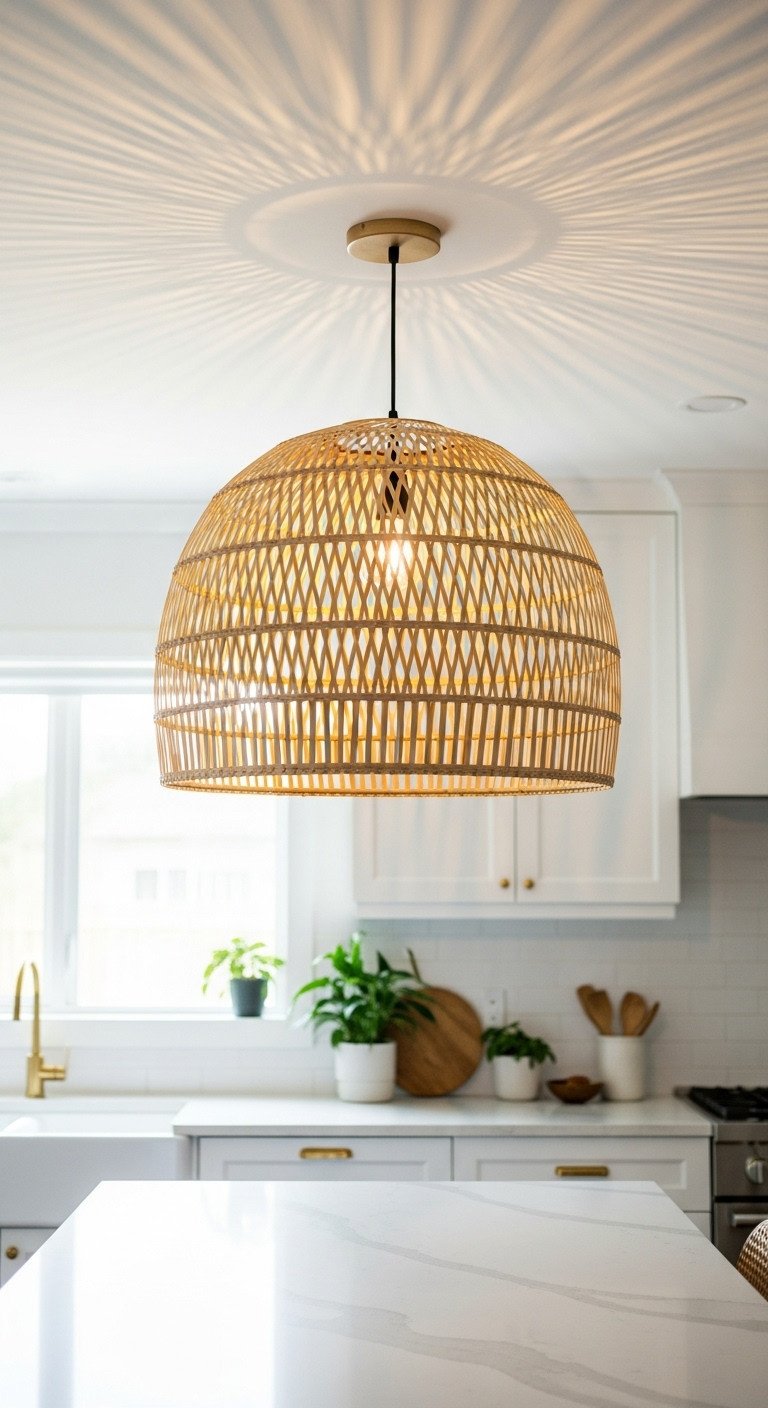
Save this for a touch of natural texture in your kitchen!
- Materials Needed: Large bamboo pendant light, mounting hardware (included), dimmable vintage-style LED bulb.
- Step-by-Step Directions:
- Measure your island. A good rule of thumb is for the pendant’s diameter to be about 1/2 to 2/3 the width of the island.
- Turn off the power at the circuit breaker before installation.
- Follow the fixture’s instructions to attach the mounting bracket to the ceiling electrical box.
- Connect the wires: black to black, white to white, and green/copper to the ground screw.
- For an open-weave design, use a vintage-style Edison LED bulb. The exposed filament adds a warm, decorative element that complements the bamboo.
Lesson Learned: Be mindful of the shadows cast by open-weave pendants. While beautiful for ambiance, ensure you have other light sources (like recessed lights) for tasks that require clear, direct illumination.
3. The Sleek Minimalist Wooden Linear Light
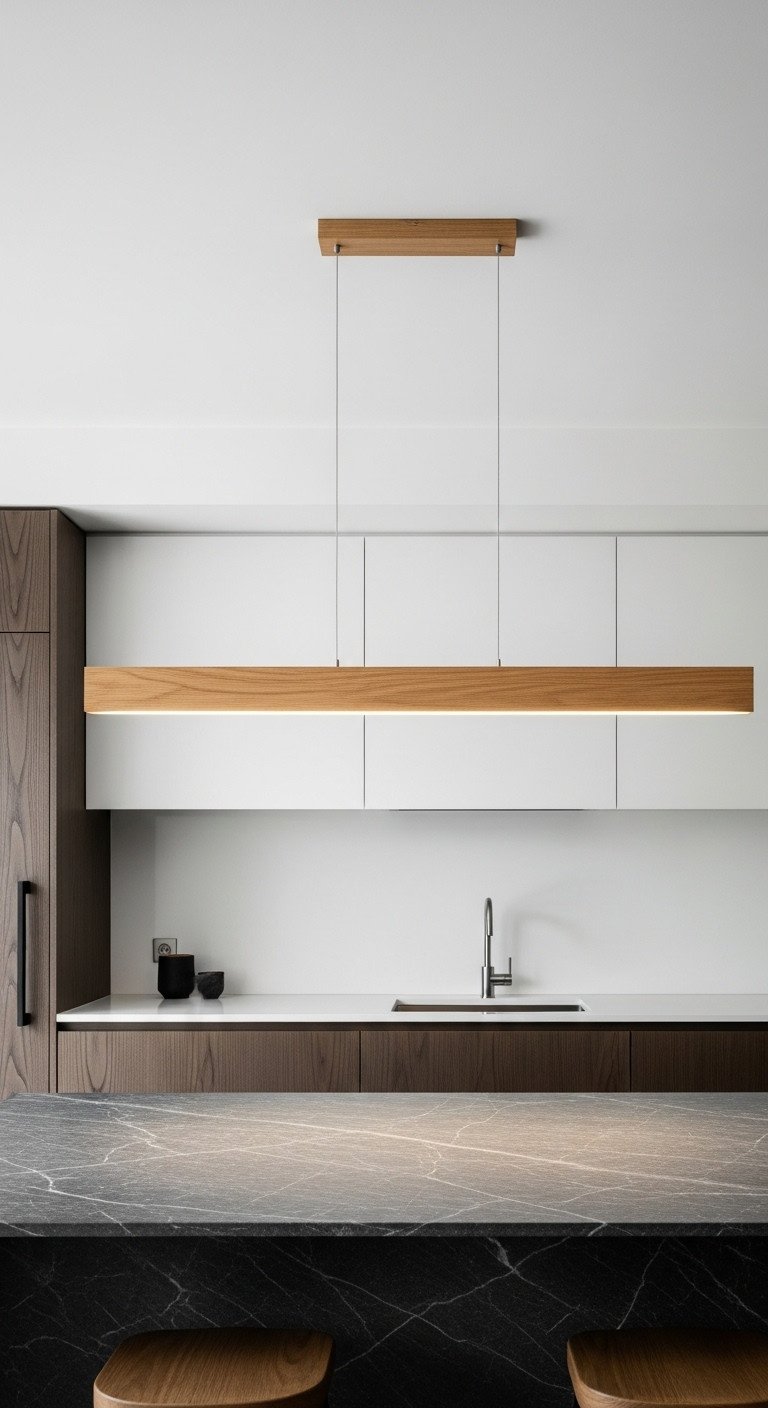
Love modern minimalism? Pin this sleek idea!
- Materials Needed: Wooden linear suspension light, adjustable suspension cables (usually included), mounting hardware.
- Step-by-Step Directions:
- Select a fixture that is at least 6 inches shorter than your island on both ends to avoid a top-heavy look.
- Installation often requires two people due to the length and weight. Always turn off power first.
- Mount the ceiling canopy and attach the suspension cables. Most modern fixtures use low-voltage power through these cables.
- Look for a model with an integrated, dimmable LED strip to ensure a seamless look without visible bulbs. This provides excellent, even task lighting for food prep.
- Adjust the cables to hang the fixture 30-36 inches above the counter for optimal illumination without being in your line of sight.
Pro-Tip: Choose a wood tone for your linear light that either matches your cabinets for a cohesive look or contrasts with them (e.g., light oak over dark walnut) to create a striking focal point.
4. A Trio of Handcrafted Ceramic Bell Pendants
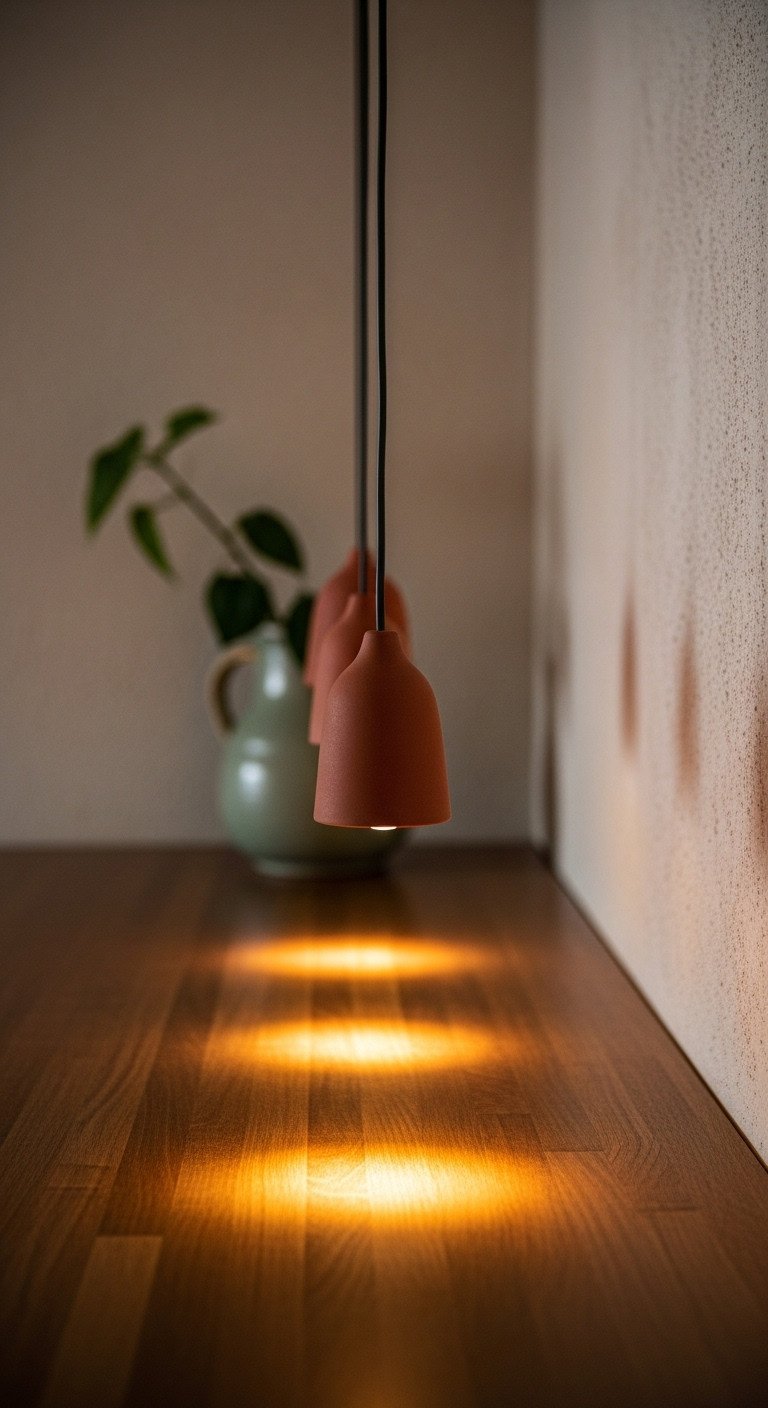
Pin this for a touch of wabi-sabi elegance!
- Materials Needed: 3 ceramic pendant lights, 3 warm-toned GU10 LED bulbs, ceiling canopy for multiple pendants (optional).
- Step-by-Step Directions:
- Plan your spacing. For a trio, hang them about 24-30 inches apart, center to center.
- To simplify wiring, use a multi-port ceiling canopy designed to hang several pendants from a single electrical box.
- Vary the cord lengths slightly for a more organic, staggered look that feels less rigid and more in line with wabi-sabi principles.
- Use focused bulbs like GU10 LEDs. The solid ceramic shade will direct all light downwards, making them perfect task lights over a prep area.
- Choose pendants with a matte, unglazed, or crackle-glaze finish to emphasize natural texture.
Pro-Tip: Don’t strive for perfect symmetry. The slight variations in handmade ceramic pieces are what give them character and charm. Embrace these imperfections.
5. The Shoji-Inspired Flush Mount Ceiling Light
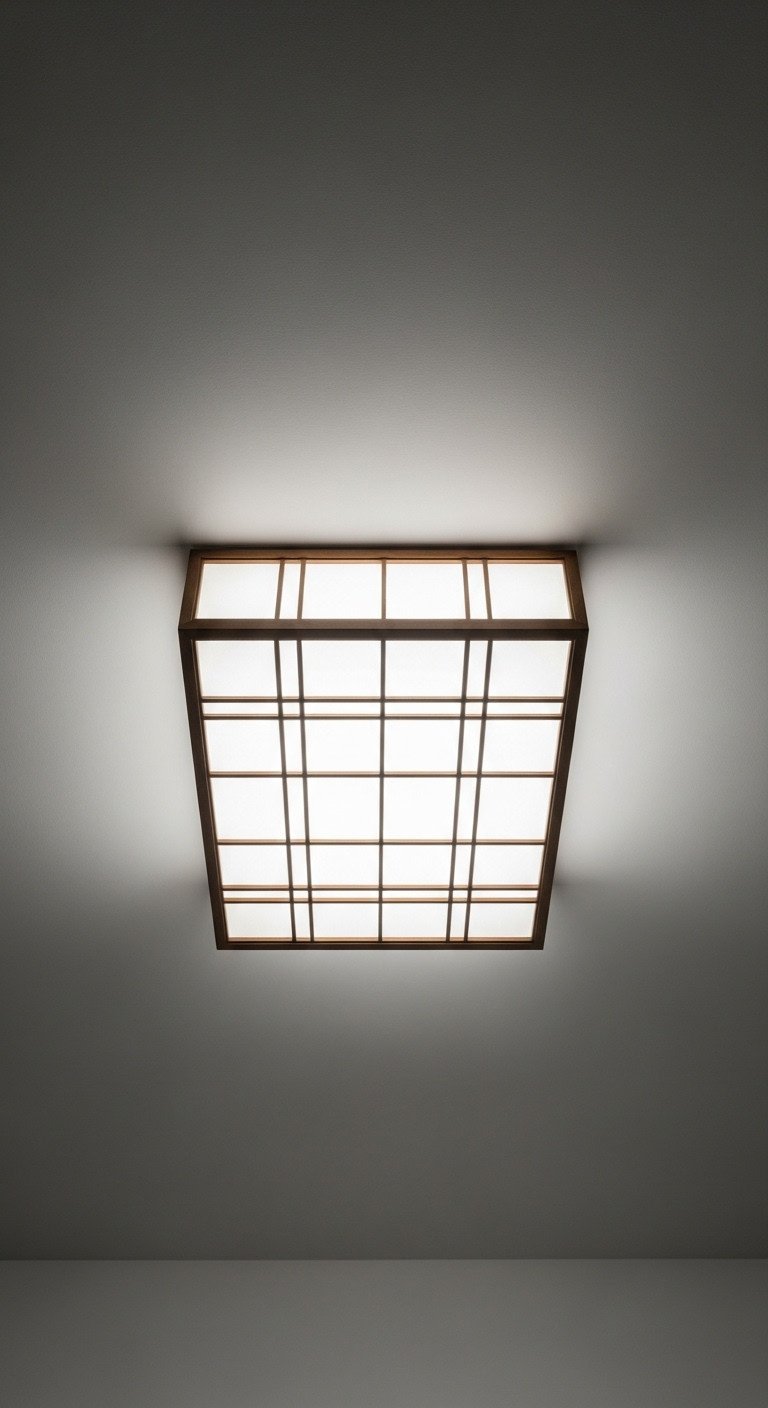
Save this for a perfect ambient lighting solution!
- Materials Needed: Shoji-style flush mount light fixture, integrated LED panel or LED bulbs, mounting hardware.
- Step-by-Step Directions:
- This style is ideal for general room illumination. Center it in the main walkway of your kitchen for the most even light distribution.
- After turning off the power, remove your old fixture.
- Install the new fixture’s mounting plate to the ceiling junction box.
- Connect the wires, then secure the main body of the fixture to the mounting plate. Many modern versions are surprisingly lightweight.
- Choose a fixture with a frosted acrylic or synthetic paper diffuser. These materials provide the shoji look with greater durability and easier cleaning than traditional washi paper.
Lesson Learned: A single flush mount provides great ambient light but can feel flat on its own. Pair it with under-cabinet task lighting and a decorative pendant to create a properly layered lighting scheme.
6. Delicate and Airy Rattan Dome Pendants
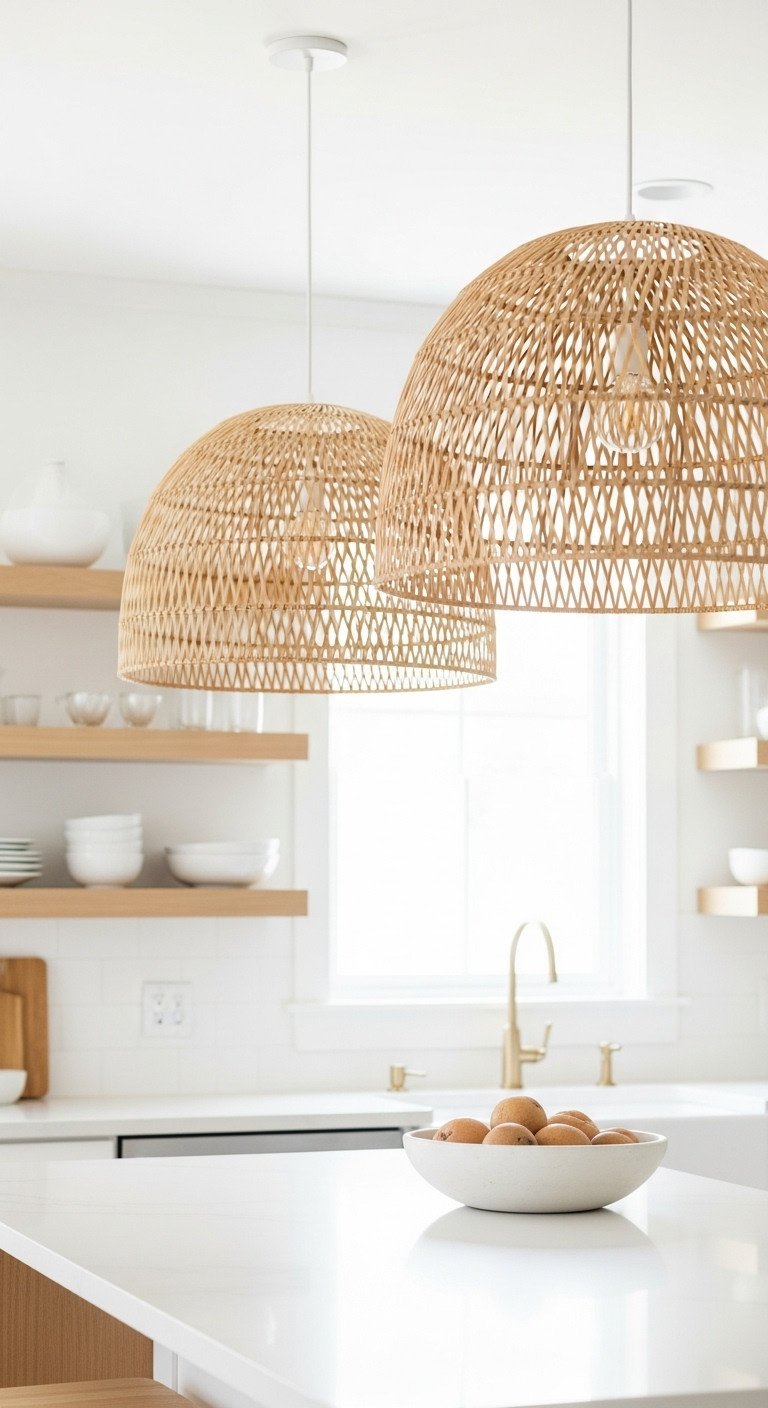
Pin this for a light and airy Japandi vibe!
- Materials Needed: 2 rattan dome pendants, 2 warm white LED bulbs, ceiling mounting hardware.
- Step-by-Step Directions:
- For islands under 6 feet, two medium-sized pendants often work better than one oversized one. Space them evenly, leaving about 12-18 inches from the ends of the island.
- Install each pendant into its own ceiling electrical box.
- Choose a pendant with a natural, light-colored rattan to keep the space feeling open and bright, a key element of the Scandinavian side of Japandi.
- Pair with a simple, frosted globe LED bulb. This provides a soft glow without the harshness of a clear bulb seen through the open weave.
- Hang them so the bottoms are at the same height for a clean, cohesive look.
Pro-Tip: Rattan is a natural material that can vary slightly in color. If buying a pair, try to purchase them from the same batch or retailer to ensure they match as closely as possible.
7. Subtle & Seamless Indirect LED Lighting
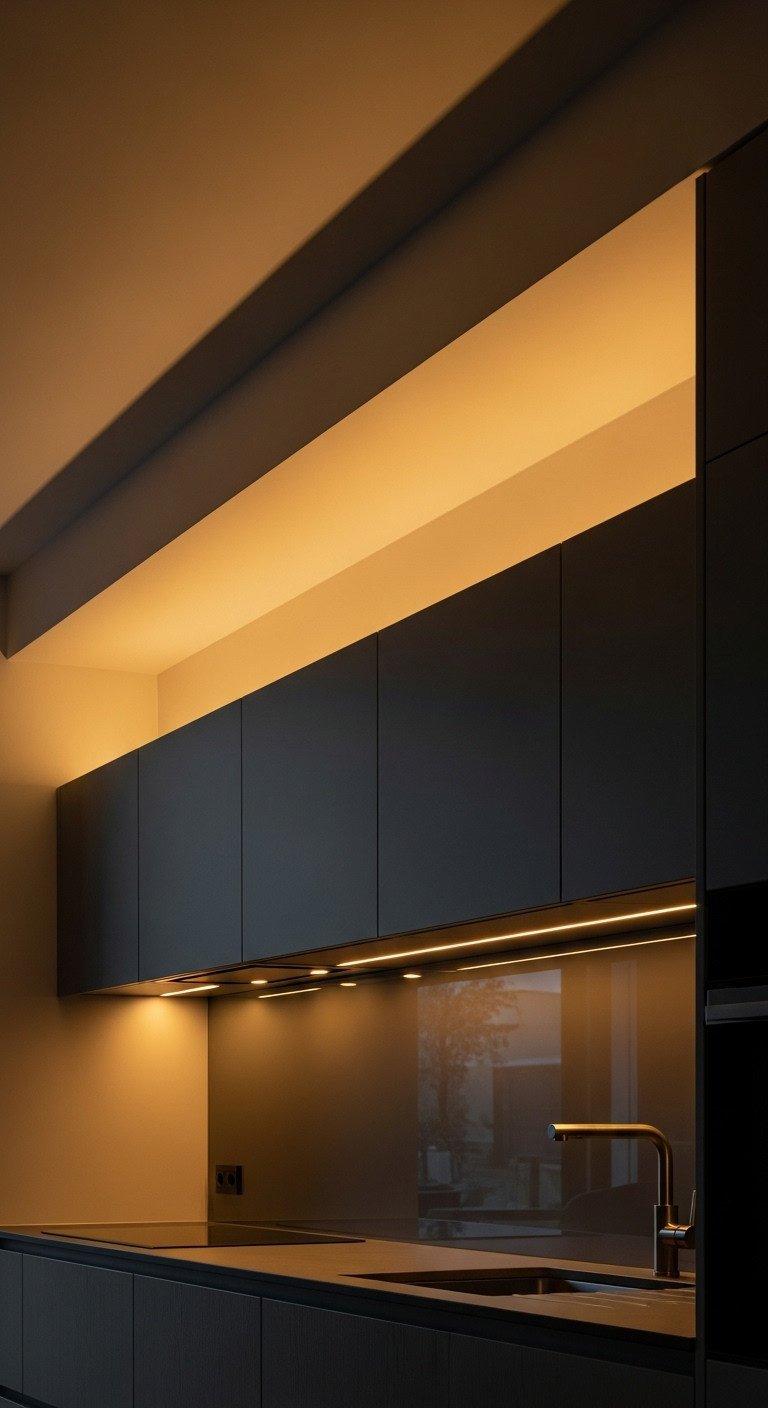
Save this for the ultimate minimalist lighting hack!
- Materials Needed: Dimmable warm white LED tape light kit, aluminum channel with diffuser (optional), low-voltage power supply.
- Step-by-Step Directions:
- Identify locations: Under upper cabinets for task lighting, above cabinets (cove lighting) for ambient glow, or along a toe-kick for a floating effect.
- Measure the length needed and purchase an LED tape light kit that can be cut to size. Ensure it’s dimmable.
- For a professional look and better heat dissipation, stick the self-adhesive LED tape inside an aluminum channel with a frosted diffuser. This prevents seeing individual LED dots reflected on your countertops.
- Install the channels in your desired locations, then run the low-voltage wiring back to the hidden power supply, which can be placed inside a cabinet or pantry.
- Connect to a compatible dimmer switch for full control over the mood.
Lesson Learned: Pay close attention to the color temperature (CCT). A 3000K light is a good neutral warm, while 2700K is warmer and cozier. Inconsistent color temperatures will ruin the seamless effect.
8. Simple Wabi-Sabi Inspired Wall Sconces
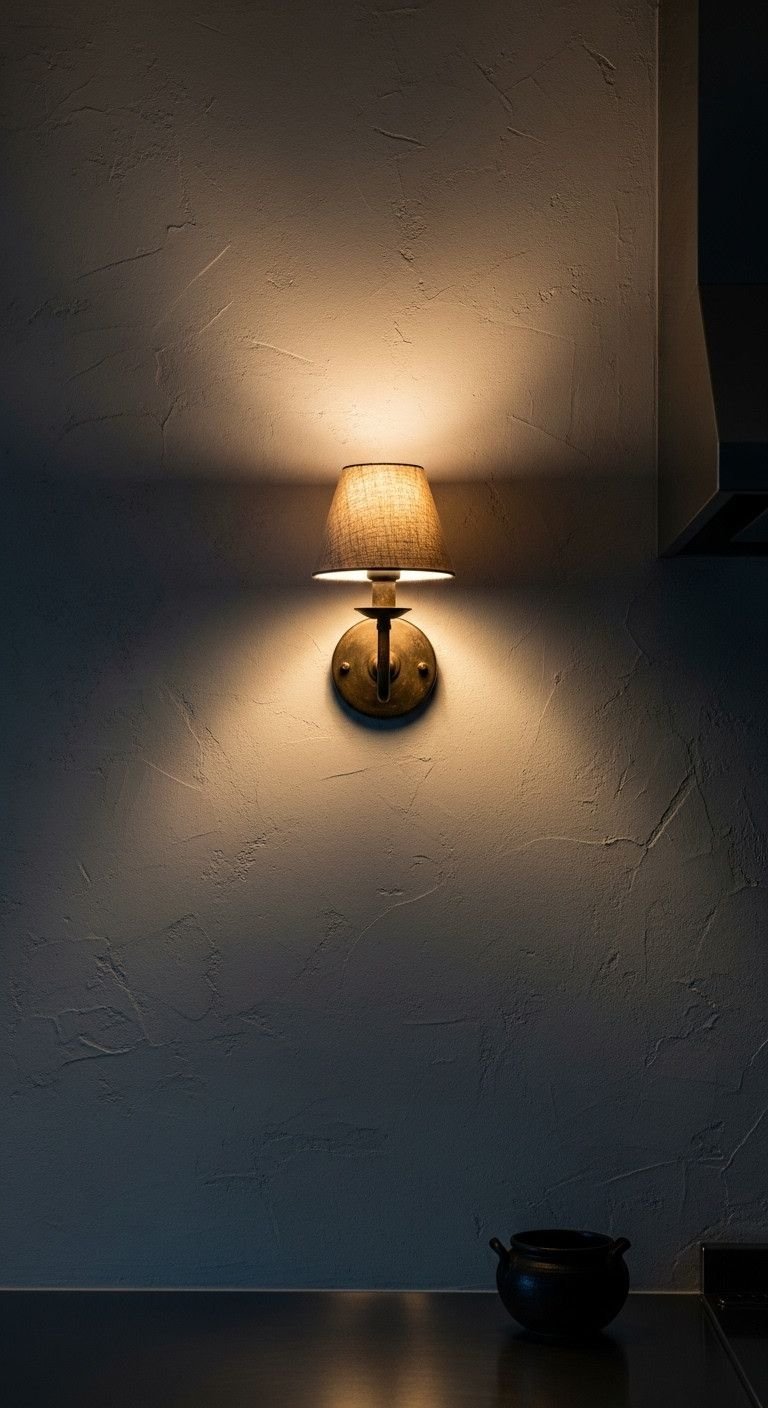
Pin this for a touch of imperfect beauty!
- Materials Needed: Wall sconce, candelabra-style LED bulb (warm white), wall anchors, wiring supplies.
- Step-by-Step Directions:
- Use wall sconces to flank a window, frame a piece of art, or illuminate a small section of countertop where upper cabinets are absent.
- Turn off power and install a junction box if one isn’t present (consult an electrician for this).
- Mount the sconce’s backplate to the wall, connect the wires, and attach the fixture.
- Choose a sconce made from natural, honest materials like unlacquered brass, blackened steel, or ceramic. A simple fabric shade made of linen or coarse cotton will diffuse the light beautifully.
- Install on a dimmer switch to adjust the accent light from a functional glow to a subtle, evening mood.
Pro-Tip: In Japanese design, light and shadow are equally important. An up-and-down sconce creates a beautiful play of light (wash) on the wall, adding depth and texture to the space.
9. A Minimalist Cluster of Glass Globe Pendants
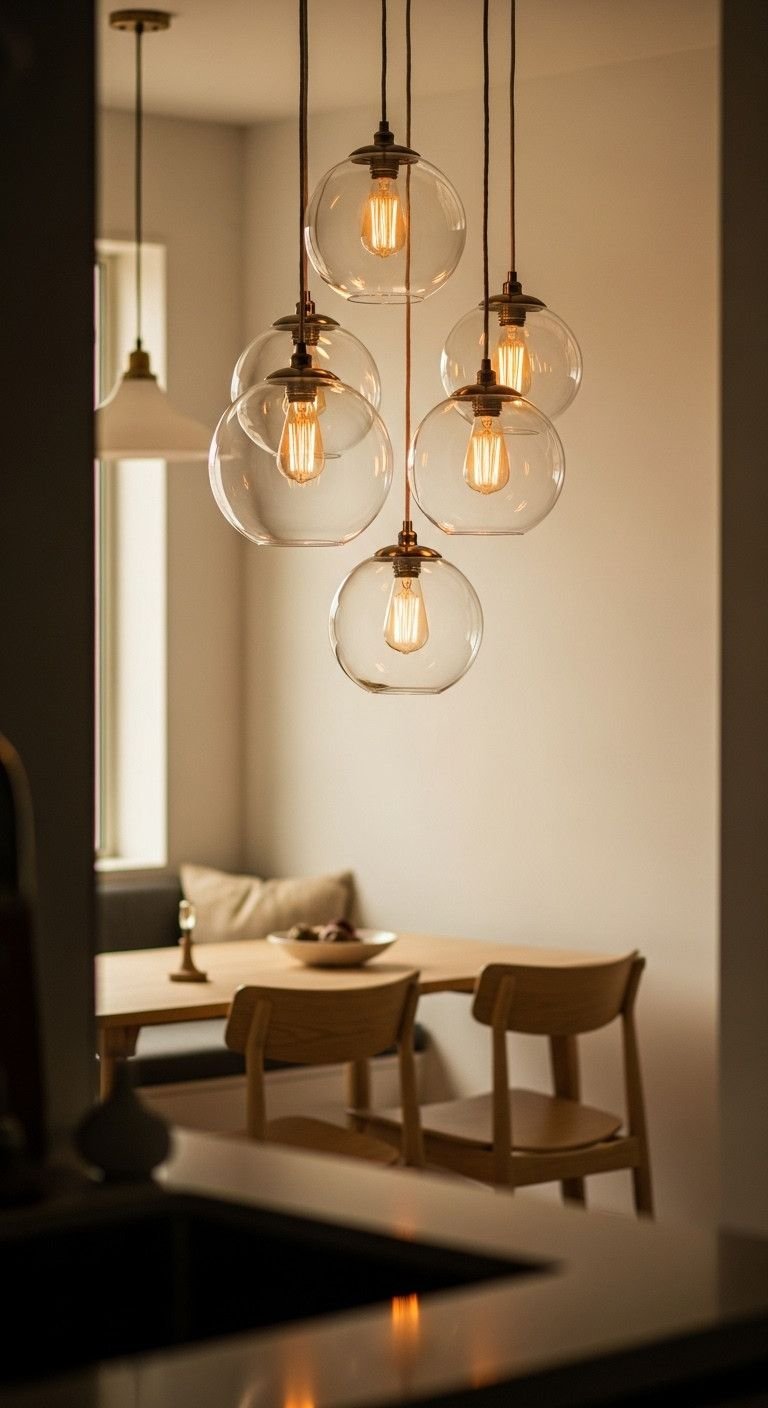
Save this for a touch of modern elegance!
- Materials Needed: Cluster of glass globe pendants (or individual pendants), multi-port ceiling canopy, dimmable vintage LED filament bulbs.
- Step-by-Step Directions:
- This works best in a corner or over a round table where it won’t be in a direct walkway.
- Use a multi-port ceiling canopy to make installation far easier, allowing you to hang 3, 5, or more lights from a single electrical point.
- Plan your composition before hanging. Lay the lights on the floor to arrange the different sizes and determine the ideal drop length for each cord. Stagger them for a dynamic look.
- The key to making this work in a Japanese-inspired space is the bulb. Use low-wattage, warm-dim LED filament bulbs (2200K-2700K) that provide a gentle, amber glow rather than harsh, bright light.
Pro-Tip: Clear glass shows dust and fingerprints easily. For a lower-maintenance option that still feels airy, consider pendants with frosted or smoked glass globes.
10. The Softness of a Fabric Drum Pendant
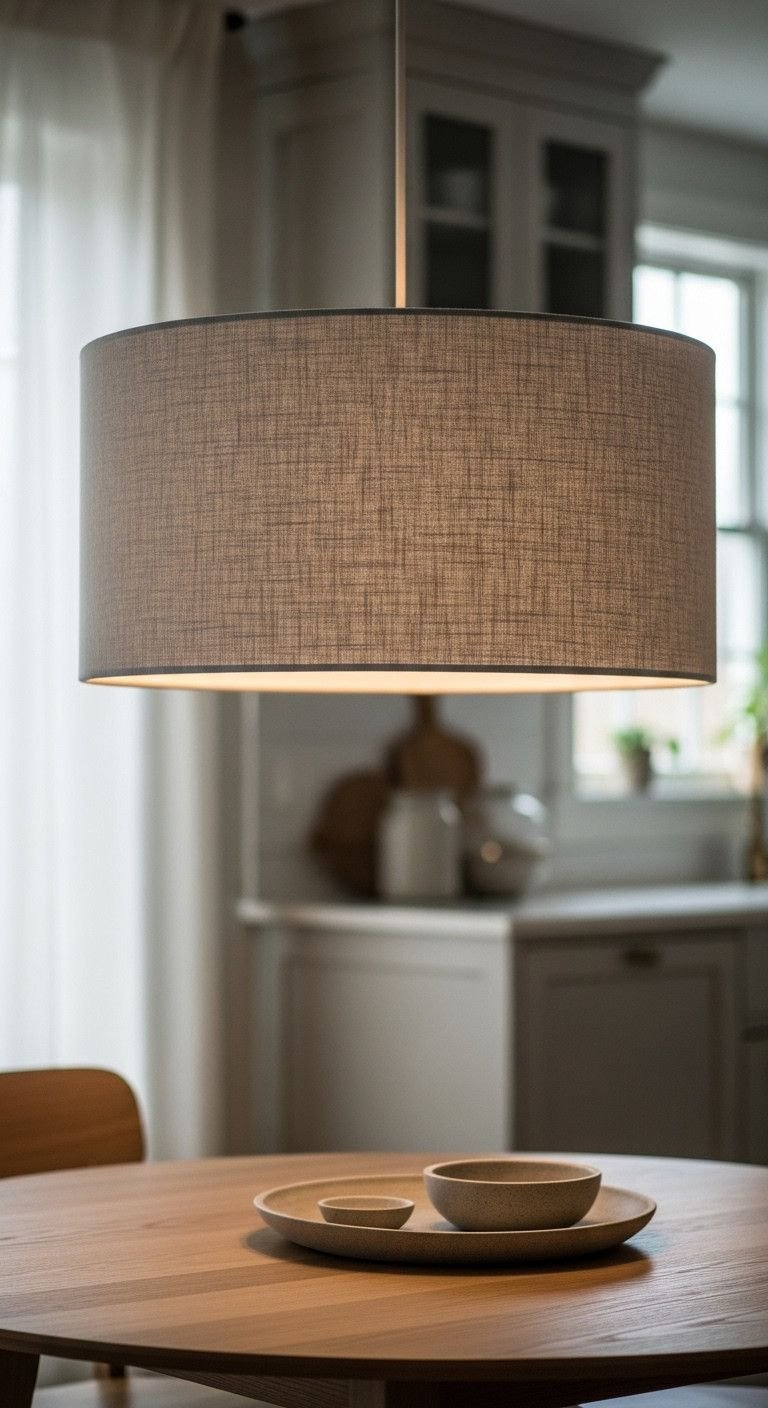
Pin this for the ultimate cozy kitchen corner!
- Materials Needed: Fabric drum pendant with diffuser, mounting hardware, warm white LED bulbs.
- Step-by-Step Directions:
- Choose a large, wide drum shade for over a table. The diameter should be about 12 inches less than the table’s width.
- Hang it low, with the bottom of the shade about 30 inches from the tabletop, to create a sense of intimacy.
- Crucially, select a drum pendant that includes a bottom acrylic or fabric diffuser. This piece covers the bottom opening, hiding the bulbs and spreading the light evenly and softly, preventing any harsh glare for those seated at the table.
- Use multiple low-wattage bulbs inside instead of one high-wattage bulb to ensure even illumination across the diffuser.
Pro-Tip: Opt for shades made from natural fabrics like linen, cotton, or burlap in neutral colors (oatmeal, grey, cream) to align with the Japanese and Scandinavian aesthetic.
11. The Sculptural Beauty of a Noguchi-Inspired Akari Light
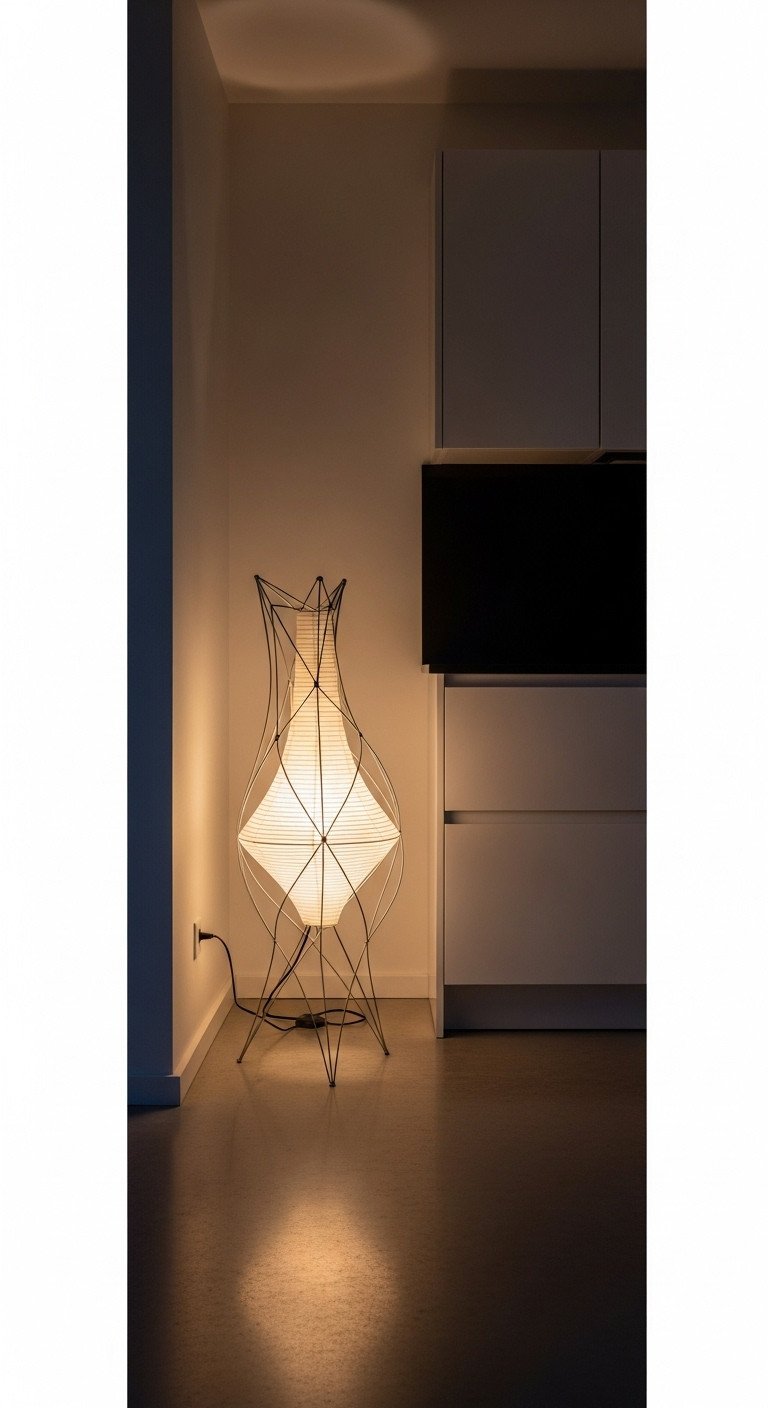
Want art and light in one? Pin this iconic look!
- Materials Needed: Akari-style floor lamp.
- Step-by-Step Directions:
- This isn’t for task lighting. Use a sculptural floor lamp in an unused corner, next to a small seating area, or at the end of a cabinet run to add a soft, ambient layer of light.
- Assembly is simple: typically, you expand the washi paper shade over the internal wire frame that connects to the base.
- The beauty of these lamps is their function as “light sculptures.” They look as good off as they do on.
- Use a very low-wattage, warm-white LED bulb (4W-7W, 2700K). The goal is a gentle glow, not bright illumination. The paper shade is delicate and the design is meant to be subtle.
Pro-Tip: An authentic Vitra Akari lamp is an investment. High-quality reproductions can offer a similar aesthetic, but ensure they use genuine washi paper and a sturdy base for longevity and the right light quality.
Key Takeaways: Your Quick Guide to Japanese Kitchen Lighting
- Embrace Warmth: Always choose bulbs with a warm color temperature (2700K-3000K) to create a cozy, inviting atmosphere. Avoid cool or blue-toned light.
- Layer Your Light: Don’t rely on a single overhead light. Combine ambient (ceiling lights), task (pendants, under-cabinet), and accent (sconces) lighting for depth and functionality.
- Focus on Natural Materials: Incorporate fixtures made of wood, bamboo, rattan, ceramic, and washi paper to add texture and an organic feel.
- Prioritize Simplicity: Opt for clean lines and minimalist shapes. The fixture should complement the space, not overpower it.
- Control is Key: Use dimmer switches wherever possible to adjust the lighting to suit the time of day and desired mood.
https://www.aliexpress.com/item/1005002450726611.html
People Also Ask About Japanese Kitchen Lighting
What is Japandi style lighting?
Japandi style lighting is a harmonious blend of Japanese minimalism and Scandinavian functionality. It features clean lines, natural materials like wood and paper, and a focus on warm, soft, layered illumination. The goal is to create a serene, uncluttered, and highly functional space that feels both cozy and sophisticated.
What color temperature is best for a Japanese-style kitchen?
The best color temperature for a Japanese-style kitchen is a warm white, typically between 2700 Kelvin (K) and 3000K. This range mimics the soft glow of incandescent bulbs or candlelight, fostering a calm, relaxing, and inviting atmosphere that is central to the aesthetic. Avoid anything over 3500K, which can feel harsh and clinical.
How do I light a kitchen island in the Japandi style?
To light a kitchen island in the Japandi style, hang one large statement pendant or a series of 2-3 smaller pendants made from natural materials like bamboo, rattan, wood, or ceramic. Position them 30-36 inches above the countertop. Ensure they are on a dimmer switch and provide warm, focused light for tasks without creating glare.
Final Thoughts
Your kitchen should be a place of calm, not chaos. By choosing lighting that embraces warmth and natural simplicity, you can transform it into the serene heart of your home. Which of these lighting ideas inspired you the most? Let us know in the comments below
Last update on 2025-10-15 at 12:24 / Affiliate links / Images from Amazon Product Advertising API
